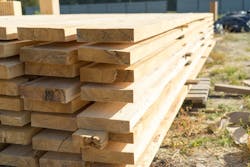What Does the Volatility of Lumber Prices Reveal About the Economy?
Throughout the chaotic rise and fall of lumber prices, the price of raw lumber stayed relatively consistent, according to NPR. Instead, slowed sawmill production and other supply chain issues pushed lumber prices to new heights, reaching $1,514 per thousand board feet in May of 2020. Now that prices are falling again, economists are pointing to cooling demand that is relieving some of the pressure on lumber production. As people are heading off to vacation, splurging on dining out, and picking up the pieces after a hard year, homeowner's budgets for home improvements are shrinking. However, as production doesn't seem to be speeding up and curveballs like the Delta variant loom, it's unknown if this is a long-term trend or a brief reprieve for lumber production.
RELATED: Track 2021 Lumber Prices: Latest News and Updates
Professional homebuilders also got busy, as rock-bottom interest rates and a desire for more space pushed demand for housing into high gear.
According to the National Association of Home Builders, single-family home construction jumped 12% last year, and remodeling activity climbed 7%. Meanwhile, domestic sawmill output rose just 3.3%.
As a result, lumber prices soared — from $349 per thousand board feet in April 2020 to $1,514 this May, according to the trade journal Fastmarkets Random Lengths.
"It was absolutely an astonishing run," Stock says.
That run in lumber prices sparked concerns about inflation as prices across a range of goods similarly jumped.
